The Mitrailleuse was one of the first pseudo-machine guns – the first ones were developed prior to the Gattling, but they continued to be purchased by military forces through the 1870s. There were several versions, the two most common being the Reffye and Montigny designs. We are taking a look at the Montigny today, which used a cluster of 37 barrels, each chambered for a 10-12mm caliber cartridge (the specific cartridge would depend on the request of the buyer).
The Montigny used a removable cartridge plate for loading, which allowed it to maintain a very high rate of fire (as long as loaded plates were available to the gunners). The breech was a large block containing 37 separate firing pins, which the cartridge plate attached to the front of. A large lever at the rear of the gun connected to a knee-joint type cam that would push the breechblock forward, chambering the 37 cartridges and locking the breechblock in place. A second lever on the side of the gun would then be pulled up vertically, firing the barrels in succession.
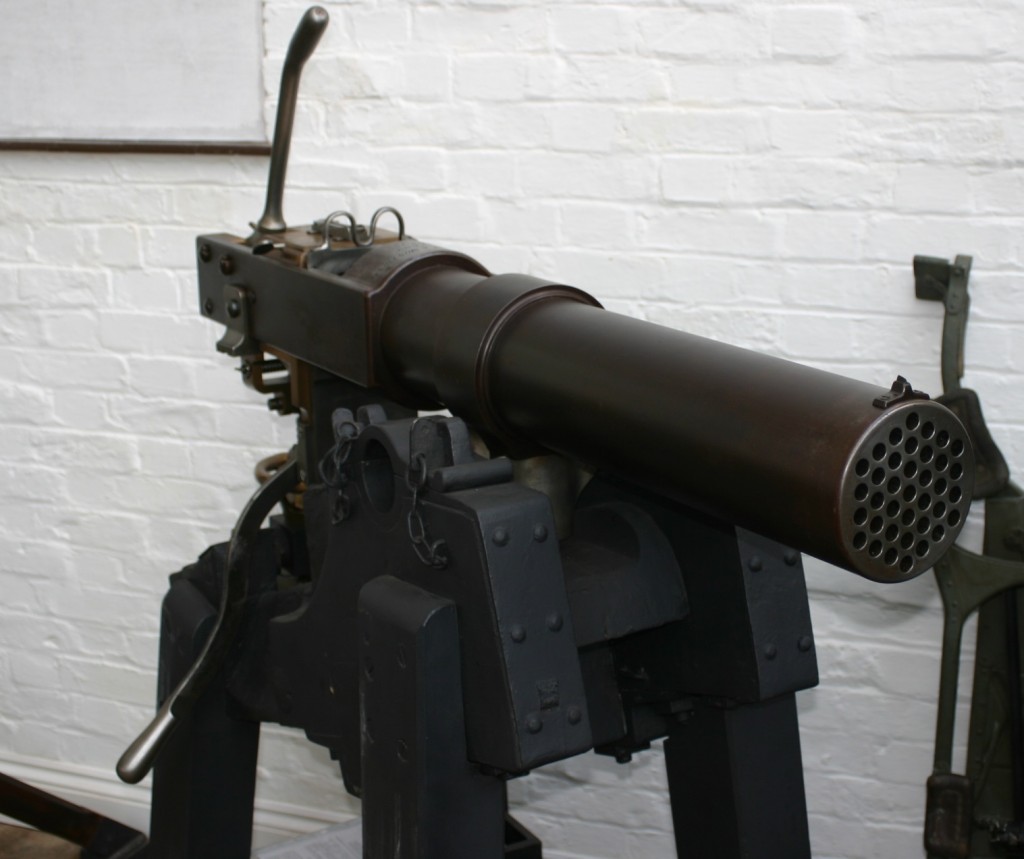
The firing mechanism was quite simple. When the breechblock was pulled rearward, all of the firing pins would be cocked against their own individual springs, and a plate would slide up between the firing pin and its port in the front of the breechblock. The firing lever simply pulled that bloacking plate downward, allowing the firing pins to snap forward against their cartridges in sequence. The rate of fire would be determined by the speed with which the firing lever was pulled, and could be as slow as single shots if the gunner was careful.
Once the cartridges had all been fired, the rear lever would be used to unlock the breech and pull it backwards. The cartridge plate (now full of empty cases) would be pulled out the top of the gun, and a fresh loaded one put in its place. This sequence would be repeated as desired until the gun overheated or ammunition ran out.
The Mitrailleuse as a general type of firearm saw only one major combat usage, and that was the Franco-Prussian War of 1870-1871. The French had adopted the Reffye Mitrailleuse (which had 25 barrels, and a screw-type locking mechanism instead of Montigny’s knee joint, but were otherwise similar for practical purposes) and considered it a game-changer. Unfortunately for the French, the tactical understanding of how to use a weapon like the Mitrailleuse was still totally lacking. The guns were treated like artillery, and used to fire at ranges of 1500m or more against German troops. The sights on the Mitrailleuse were simple post and notch affairs like rifles of the day, and the extreme range called required excellent range estimation (which the gunners were not trained for). To compound the problem, the combination of long range and small projectiles made it nearly impossible to observe point of impact when firing, and it was nearly impossible to actually hit targets as a result.
The problems with French use of the Mitrailleuse were compounded by the secrecy surrounding the guns. The Army was so focused on preventing the Germans from discovering the guns that virtually no training was given to troops on their use – few had even seen them prior to battle.
As a result of their utter failure to provide the French Army with an advantage, a general feeling of the inferiority of all such rapid-fire rifle-caliber weapons would permeate military culture for several decades. Ultimately, it was only the use of Maxim guns in WWI that would change the minds of generals and ordnance departments worldwide (although the forward-looking few did learn from conflicts like the Russo-Japanese War).
This particular Mitrailleuse is Belgian, made by Christophe & Motigny:

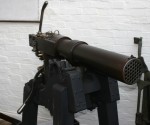
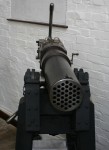

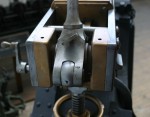









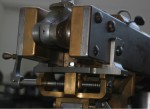









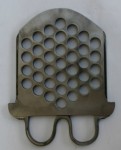
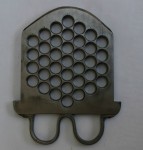




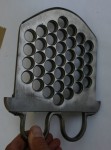



















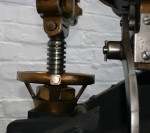









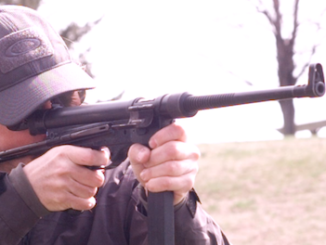
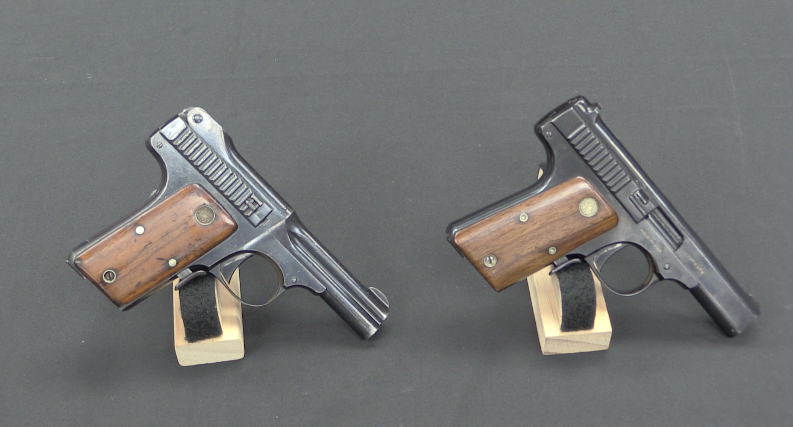
I know that the Mitrailleuse wasn’t that great, but when used properly, it would reduce incoming Prussians to LUDICROUS GIBS! The Prussian soldiers feared getting drilled by these heavy monsters and made them primary targets for snipers and artillery. As a result, I’m quite sure that Imperial Germany wanted to out-do everyone at heavy rapid-firepower, thus the scene of Kaiser Wilhelm II personally test-firing a Maxim gun and nearly wiping out his general staff in the process…
Heh, you said Ludicrous Gibs!
Lol, get a mop!
“get a mop!” – Hey, as a recovering Navy (M-14 and 1911 era) issue swabbie, I resemble that remark!
(Actually, we didn’t have mops on submarines, but I still answer to “Yo, swabbie!”)
That would be incorrect on how the majority of these pieces were taken out. The de Reffye Mitrailleuse as used by the French Army under Emperor Napoleon III was deployed in the Artillery regiments which were reorganized just prior to the Franco-Prussian War to three batteries. These would be two batteries of La Hitte muzzle loading guns and one battery of 10 Mitrailleuse, and all would be deployed with an emphasis on defense. The Prussian Krupp breechloading artillery far and away outranged these La Hitte guns by almost two kilometers and the Prussian doctrine was to open up with counterbattery-fire, then move up to support the infantry advance once the enemy artillery was either destroyed, routed, or left incapable of properly laying down effective fire.
This is unbelievably high-tech for its time; very elegant and clean. It is convincing testimony of metallurgy and machine-building capabilities of middle 19 century. French were always good at that even away from guns. How generals were able to use it in their favour is quite separate story. The 1870-71 war was as a result swift victory for Germans.
Oh yeah… and we would almost forget: there was one already in 1718 – James Puckle’s gun.
http://en.wikipedia.org/wiki/Puckle_gun
Original is in London’s Tower but many other replicas were made by enthusiasts.
This was true ‘cranker’ with one specific and distinct advantage. It could use either round or square shots. The former were to be used primarily on fellow Christians, latter on Turks to teach tem benefits of allegedly superior civilisation. A racist gun, basically.
Not understanding the proper use of a “new weapon” has apparently been a problem with military leadership since the beginning of warfare.
And is seems that the leader that does figure it out was someone who wasn’t ‘doing well’ in the military or had no military training. Normal military structure favors those who blindly obey.
Then the leader that did figure it out goes down in history as a great general/leader. The US Civil war has few of these from both sides.
You are quite correct, Martin. A close examination of history and its countless ironies and twists of fate would reveal that many ( not all ) of those who have been credited with “figuring it out” either did so after someone else already had it worked out ( but who was ignored due to any combination of factors ), plagiarized that someone else’s ideas, or were incorrectly credited by historians. This applies to every period in history and to all categories of human endeavour, not just those associated with weapons and firearms.
Another problem with the “secret weapon” thing was that as with the M1897 75mm field gun, the French army trumpeted far and wide that they had a “secret weapon” that was absolutely devastating in its effects. The other chancelleries in Europe noticed, as the French intended they should.
Trouble is, the other chancelleries didn’t react quite as the French hoped they would. Most obviously, the Prussians.
Having been thoroughly convinced of the weapon’s power (even if they didn’t know exactly what it was actually supposed to do anymore than the average poilu’ did), the Prussians dealt with the Mitrailleuse with typical Teutonic efficiency.
I.E., when a unit of them showed up on the battlefield, it was immediately greeted with the heaviest artillery fire the Prussians could bring to bear on its location.
And since the French didn’t employ it properly (as short range support), said Mitrailleuse unit could not reply effectively. Field guns generally outranging what were fundamentally rifle-caliber weapons, even then.
The result, as you might expect, was that most such unis died without contributing much to the battles the were sent into. Except being target butts for Prussian cannon.
Oops.
cheers
eon
That’s what I just said. Anyways, the Prussian high command (and tons of foreign military powers) had little respect for rapid-fire weapons at the time, and the failure of the Mitrailleuses overall made them think that machine guns were crap. Ordinary soldiers knew what would actually happen if a commander bunched his infantry together and charged a set of machine guns-instant slaughter. When Prussian artillery could not support its allied infantry, the French gunners had the advantage.
More technical problems: Since the Mitrailleuse was treated as artillery, it had limited traverse (and slow elevation) and was too heavy to swing around. If the mount had been one with a free traverse and properly counterbalanced elevation control, I’m quite sure that the Mitrailleuse would have been more effective than on an artillery carriage. Any ideas?
I’m guessing QCB’s was not an option.
If you read up on the war of 1870, the main problem the French had was the short range of their artillery, by it the Mitrailleuse or standard cannons. The French still used timed shrapnel grenades with a maximum range of 2500 m, the Germans had impact fuses and could fire effectively up to 3500 m. What makes it very painful if you’re sitting in a 2 miles x 2 miles valley with 100,000 men and 500 artillery pieces are shooting at you from all around, like in Sedan.
What was the war-tech used in U.S. at that time, for comparison? The Civil war is known to be time of quantum leap, specifically in artillery.
Still the same muzzle-loading smoothbores and rifled muzzle-loaders used in the Civil War. The U.S. Army didn’t put great emphasis on rifled breech-loading field guns until the late 1880s.
There were two main reasons. First, they had just won a war with the 12-pounder Napoleon and its kin. And second, the majority of the rifled breechloader designs available prior to about 1880 weren’t that strong and didn’t have reliable breech sealing.
Both the Union and Confederate forces had used imported breechloading guns (British-made Armstrong and Whitworth guns for the most part) in the war, and had found that they weren’t really enough of an improvement over the muzzleloaders to be worth the expense. The biggest drawback being that while the BLs could generally be loaded a bit faster, without a recoil system to damp the “kick”, they had to be repositioned and relaid for each shot just like the MLs, which was the real factor that governed rate of fire at the time. The breechloaders only became really practical, and showed their true superiority in ROF, when recoil systems (spring, hydraulic, etc.) were developed; hence the term “Quick-Firing” or “QF” gun.
Also, the breech mechanisms of the day weren’t really all that fast, unlike the later ones like the Krupp sliding block, the interrupted screw, etc. In fact, a trained and experienced crew with a Napoleon could fire (aimed) solid shot, shell or spherical case every thirty seconds (time to cut the fuse factored in), and canister once every fifteen seconds (the latter was a bit faster because it was loaded as a “fixed” round, powder bag attached to the canister’s bottom). Canister was a short range “self-defense” round, that basically turned the gun into a large-economy-sized shotgun.
More than once, the Whitworth breechloader (that used a peculiar hexagonal cross-section brass cartridge case due to its hexagonal bore) was used with a sheet of brass or copper (or just the cut-off head of an empty cartridge case) sealing its breech, and just being loaded “down the spout” in the way typical of MLs. The ROF was about the same. (The Armstrong could not be used this way, as it had a powder chamber larger than its multigroove-rifled bore.)
BTW, the 12-pounder Napoleon smoothbore (4.62″ bore, 66″ tube, all-up weight on carriage 2255 lbs.) had a maximum effective range of about 2000 yards, and a horizontal deviation from point of aim of 3 feet at 600 yards and 12 feet at 1200. This works out (in modern artillery terms) to under 2 mils and about 33 mils, respectively, which is pretty impressive for a gun with no rifling firing round shot.
So much for the idea that smoothbore muzzleloaders were short-ranged and inaccurate. Even after the advent of the rifle musket, they still ruled to battlefield as long as they didn’t try anything fancy like charging up to Napoleonic (point blank) range against infantry on the defense. As long as the artillery was on the defense, they pretty much had things their own way.
(Data courtesy of Arms and Equipment of the Civil War by Jack Coggins, Doubleday, 1962.)
cheers
eon
Good reading, thank you!
I also read some time ago about deBange obturator which was capable of effective breech closure. However it appears that development started in 1877 which would have been too late for both, the Franco-German and U.S.Civil war.
http://en.wikipedia.org/wiki/Charles_Ragon_de_Bange
I wonder what was the British pieces breech construction (Armstrong and Whitworth) at time they were available on NA continent. If used in Civil war, as you say, it must have been some other system. I recall seeing Whitworth costal gun in Fort McMurty in SC.
The Whitworth had a breech that worked a lot like the screwtop on a bottle;
http://www.civilwarintheeast.com/Cyclopedia/Cyclopedia-WXYZ/WhitworthGun.php
Here’s a close-up of the breech;
http://i2.photobucket.com/albums/y35/Cpt03Ed/Whitworth-2.jpg
It swung to one side on a hinge arbor much like that used on the pressure hatches on submarines in WW2.
The peculiarity of the Whitworth was that the barrel (tube) was not only hexagonal (like a bolt-head) in cross-section, it had no actual “chamber”- it was bored straight through as a twisting hexagon. The projectiles were hexagonal in form;
http://www.ndl.go.jp/exposition/e/images/R/796r.jpg
And so was the cartridge case, which was made of either brass or tin, depending on contractor. Think of a very big .22 rimfire case except hexagonal instead of round. (I can’t find an image of it anywhere for some reason- anybody?)
This is why it could be muzzle-loaded if you used something for a gas-check, either a disc of copper or brass or just a cut-of case-head. The tube was uniform for its full length inside.
There were Whitworth muzzle-loading target rifles, as well, usually about .45 caliber. Equipped with telescopic sights, they were used as sniper rifles by both sides.
The Armstrong breechloader was a different setup. It had a hollow screw that acted as a “vice” to hold a separate breechpiece that was inserted from the top much like the Montigny Mitrailleuse’s loading block;
http://upload.wikimedia.org/wikipedia/commons/4/4e/RBL_7_inch_Armstrong_breech_diagram.jpg
The shell, with a lead driving band, was rammed in through the hollow screw, followed by the bagged charge.
The Armstrong could not be muzzle-loaded, because the chamber was slightly larger than the bore and the driving band engaged the rifling in the leade just as later heavy guns’ shells do, even today.
The Whitworth was considered pretty reliable, but the Armstrong had a nasty habit of either fracturing its breechpiece, blowing chunks of it out the rear and the top, or else jamming due to heat expansion of the breechpiece in rapid fire- or just because the crew screwed the breech “vise” in too tight. (The Royal Navy, which used Armstrong breechloaders as secondary guns on their warships for a while, issued ten-pound sledgehammers to deal with this problem.)
As an interesting side note, the Whitworth and Armstrong breech systems were similar in concept to some of those used on recoilless rifles in the WW2 era and up to the 1970s. Imagine a Whitworth with a venturi on the breech and a blowout disc in the case head, not unlike the British Wombat;
http://upload.wikimedia.org/wikipedia/commons/b/bb/Wombat_Recoilless_Weapon.JPG
MOBAT (MObile Battalion Anti-Tank) had a similar setup except with a dropping breechblock, sort of the Armstrong type setup going “down” instead of “up”;
http://www.modelbouwleuven.com/resources/walkarounds/Recoiless_Gunn_Mobat/L4%20120mm%20MoBAT%20260610%20%2824%29.JPG
The Armstrong could have been modified to use a system like this with a blowout disc behind the bagged charge. The venturi could have been made by careful shaping of the breech-screw “tunnel”.
Recoilless rifles in the American Civil War? To say that might have changed the history of artillery would be an understatement.
cheers
eon
Very interesting “eon”, thank you very much! This was the missing piece in my knowledge (well, there may be more…).
I enjoy this part of history of artillery development and as you say, it was crucial in determining of new directions. I look at artillery piece as a rifle with more of power and fancier features.
Oh, and Andrew, Wilhelm II never saw a Mitrailleuse in action, he was born in 1859. The crown prince in that war was Friedrich Wilhelm, his father (who died 3 months after taking office, so he’s often overlooked).
Yes, I know that. I didn’t say that Wilhelm saw a Mitrailleuse, but I’m quite sure he might have been well informed about this stuff. When Hiram Stevens Maxim marketed his machine gun to European leaders, he asked several nobles if they would like to fire it. Suffice to know that Wilhelm fired the Maxim gun after having been prompted by his cousin, the Prince of Wales (the future King George V). He accidentally set off the automatic traversing mechanism on that particular gun and nearly killed his generals in the process (OH CRAP!). After that, the Kaiser supposedly said “That is the gun – There is no other.”
I wonder about the cost of production of this gun. When it have fewer moving parts that manually cranked firearm it have 37 bores i.e. you must make 37 aligned bores and make the rifles insides it – the crank-operated has fewer barrels depending on models from 1 or 2 to 10 (Nordenfelt) – I wonder which is cheaper – fewer barrels and more complicated mechanism or inversely.
–
When compared to crank-operated firearms the Montigny have a advantage, as is poor-ammunition-proof – it will don’t stop firing due to bulged case or breaked rim unlike the crank-repeater. When not big issue nowadays it can be considered seriously in their era – for example early British .577/450 Martini-Henry was made from rolled foil which causes the jamming of rifles.
I wonder what the failure rate was while manufacturing the barrel?
I can just imagine the language when the drill choked up with chips and broke off as the last barrel in the cluster was half way through.
I would assume they manufactured each barrel as a separate piece, and then mounted them all up together…
It varied. The Montigny and De Reffye model did indeed have the barrels made one at a time, then put together in a cluster inside a casing.
The American Vandenburg Volley Gun version;
http://www.ibiblio.org/hyperwar/USN/ref/MG/I/img/MG-1-033-6.jpg
http://www.seacoastartillery.com/gallery/images/sea8.jpg
was initially made by casting a cannon-like barrel “blank”, and then boring and rifling the barrels through it. Later versions adopted the “cluster of barrels” method, but kept the cannon “chase”-like outer appearance.
BTW, the 85-barrel model shown in the first picture was used by the Confederates in the Civil War. Unlike the Mitrailleuse, the Vandenburg didn’t fire all its rounds at once; a crank in back turned a cam-operated set of strikers that fired the barrels in sequence, somehow.
Give me a Gatling Gun any day of the week. Much less aggravation, all round.
cheers
eon
Just to clarify, the Montigy Mitrailleuse doesn’t fire all its barrels simultaneously – or at least the one in these photos doesn’t. I tried dry-firing it – sounded like a popcorn popper. 🙂
Check that link. Detailed information with excellent animation.
“www.victorianshipmodels.com/antitorpedoboatguns/Mitrailleuse/montigny.html
I love that site. I wish they would finish up the rest of the sections on the Maxim and Browning guns.
Excellent reading and pictures!
They say in text that Montigny gun was offered to Austria in 1869 and England in 1970 (just at time of war start-up!) It is hard to believe they were keeping it as a “secret” at the same time.
Especially animated explanation of both Montigny and
Reffye mitrailleuses are must to watch. Mechanically
computerised firing pins constructions design and
workmanship are over imagine.
There are some bars in uptown edge-of-Harlem New York City where for the last 50 years or so if you order a “French 75” you will get a cocktail glass that is half champagne and half congac. About as lethal as an artillery barrage. Brandy and bubbles….
Isnt this is same type of gun that been featured in Jango original series movie??
Looks very familiar there,except the movie version was belt loaded and also had many holes as this one..
The gun in Django, and a similar one in A Fistful of Dollars, are meant to look like the Mitrailleuse, but are only mockups.
I’ve never seen Django, but I was just watching “Fistful” the other night, and I’m pretty sure the “mitrailleuse” was probably an Italian Breda M37 gas-operated HMG. The “firing” barrel was at the center of the “barrel cluster” (water jacket?), as far as I could tell, so I don’t think it could have been either a British Vickers-Maxim or a German MG.08; then it would have been at the bottom. All three HMG’s receivers were about the same size, though, so who knows?
Also, I’d suspect a Breda would have been easier for an Italian film company to scare up in 1964 than either of the other two.
I was thinking at the time that making it a mockup of a Gardner two-barrel would have made more sense, as the Gardner looked a lot like a Breda, etc., except for that big crank on the side.
cheers
eon
An very interesting design,I don’t know about being a machine gun but make a multiport rocket launcher sounds good,reminds well forgottened game Shadow Warrior,particular device featured there as well…
Maybe to advanced for a time when Napoleon and his tactics were still considered the top of the top…
Mitrailleuse cames frome ”mitraille”, wich en french means shrapnel shell, and I think it was a very good name for thus type of weapon.
Last thing, the modern machine guns are still named ”mitrailleuse” in the french army.
And so is in Serbian and other armies in the area, albeit slightly altered – “mitralyez”. Russians,
Czech and some others call it literally “balls-thrower”…)))) Kind like shrapnel.
Not just French referring this senonym,Yugoslavians also call their machine guns Mitralleuse such as M53 or PKM version…
There were several mitrailleuse on display in the old colonial fort in Luanda, Angola.
I didn’t think to ask at the time, whether they’d been taken around the country with patrols (presumably requiring ox carts or pack or dedicated pack animals)or whether they were for defending forts and sea ports.
Come to think of it, I didn’t even think to ask whether they’d ever been used against humans.
I don’t know whether the colonial forces, shared Captain Blackadder’s views on war: “The kind of people we liked to fight were two feet tall and armed with dried grass. Even spears made us think twice”
“
Just bought the new CIBLES (monthly gun magazine) here in france and it has a good article on the Reffye mitrailleuse by JULIEN LUCOT A paraphrase of the article says napoleon the third decided that france needed it’s own mitrailleuse The first designs were started in 1863 by the emperors aide de camp capitan de reffye. The first dvelopments were done at the centre de MEUDON In order to keep the project secret the emperor financed it from his own pocket.. The calibre was 13mm although cartriges up tp 16mm were experimented with.The emperor gave the go ahead on the arm by the 24th of may 1864 The first trials were done at VERSEILLES in 1868.These shooting trials were done at a distance of 1400 to 2000 metres on targets 210m long and 1.80 metres high which represented a army batalion. These trials were satisfactory.
However a decision had to be given whether the guns should go to the infantry or the artillery. This had been already decided in 1864 and the mitailleuse was assigned to the field artillery
Captain Reffe is supposed to have said that the mtrailleuse were used in an idiotic manner they sould be used to fire only at long distanc . They are being used as rifles when they should be firing on the artillery at 2000 metres
Till the w<ar started there was no instruction no plan of how to site the guns or how to use them all was top secre
Aparently there were 215 guns built befor the war the first instuctions were given 8 days befor the war broke out and the top secret rating was lifted on the 20th of july 1870
The first use was at Wissembourg the 4th of august where it decimated the german troops at 2000 metres
In spite of this happy beginning problems followed as the lack of training showed up .One fact that was noted that the gunners did not have spyglasses and could not see where the bullets were falling
The real problem came from the fact that the mitrailleuse could not be protected from the german guns capable of firing to 3.5 to 4 kms
It should be noted that engravings showed the guns equiped with steel shields to protect the gunners
Hi all, I’m the writter for the article about French REFFYE in Cibles (French Magazine), Bobtail101, thanks a lot for your Post. Next month, the second article will be published with photo to the test wiht blank ammunition in the replica off the machine gun.
Best regards
Julien